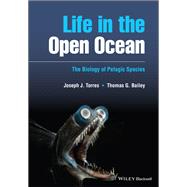Life in the Open Ocean: The Biology of Pelagic Species provides in-depth coverage of the different marine animal groups that form the communities inhabiting the ocean’s pelagic realm. This comprehensive resource explores the physical environment, foraging strategies, energetics, locomotion, sensory mechanisms, global and vertical distributions, special adaptations, and other characteristics of a wide array of marine taxa.
Bringing together the most recent information available in a single volume, authors Joseph J. Torres and Thomas G. Bailey cover the Cnidaria (stinging jellies), the ctenophores (comb jellies), pelagic nemerteans, pelagic annelids, crustaceans, cephalopods and pelagic gastropods, invertebrate chordates, as well as micronektonic and larger fishes such as sharks, tunas, mackerels, and mahi-mahi. Detailed chapters on each pelagic group describe internal and external anatomy, classification and history, feeding and digestion, bioluminescent systems and their function, reproduction and development, respiration, excretion, nervous systems, and more. The first book of its kind to address all of the major animal groups comprising both the swimmers and drifters of the open sea, this important resource:
- Explains how different animals have adapted to live in the open-ocean environment
- Covers all sensory mechanisms of animals living in the pelagic habitat, including photoreception, mechanoreception, and chemoreception
- Treats the diverse micronekton assemblage as a community
- Includes a thorough introduction to the physical oceanography and properties of water in the pelagic realm
Life in the Open Ocean: The Biology of Pelagic Species is an excellent senior-level undergraduate and graduate textbook for courses in biology and biological oceanography, and a valuable reference for all those with interest in open-ocean biology.








